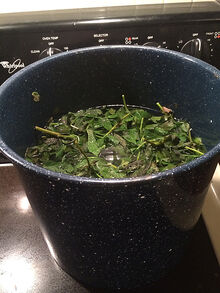The Plant[]

Mint is a perennial plant that can be started from seeds or clippings. It is slow to germinate, but can quickly overrun a garden. Mint loves full sun and loamy soils rich in organic matter. [1] Mint is aromatic and often used in cooking and for tea. Because it creates runners and quickly propagates, it is easy to produce enough to dye with. Mint oil is also used to deter insects and common pests. [2]
How to Harvest[]
Harvest the mint leaves if you wish the plant to continue to grow, or if you want to thin an area, harvest the whole plant. Mint can be cut back hard and will usually bounce back quickly. [2]
How to Extract Color[]


Mint produces yellows with alum or no mordant. It produces mint-green with the use of an iron modifier. The leaves contain the most dye, but the whole plant may be used. Leaves can be processed quickly in a hot bath or steeped more slowly in a cold bath to extract color. Leaves should be steeped until they turn brown, then strained from the dye bath. The dye bath is then ready to use. [2]
References[]
- ↑ McLaughlin, C. (2014). A garden to dye for: How to use plants from the garden to create natural colors for fabrics and fibers. Pittsburgh, PA: St. Lynn's Press.
- ↑ 2.0 2.1 2.2 Duerr, S. (2010). The handbook of natural plant dyes: Personalize your craft with organic colors from acorns, blackberries, coffee, and other everyday ingredients. Portland, Or.: Timber Press.